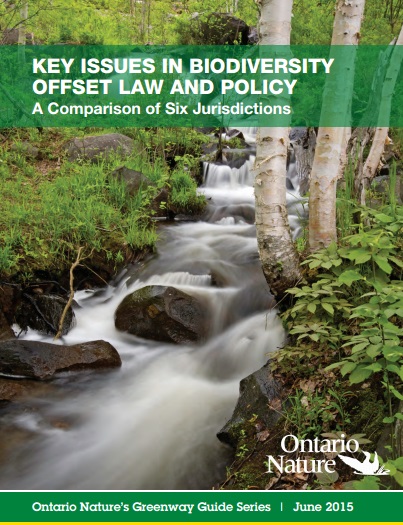 Some time ago I have been asked by Dave Poulton to review a chapter on biodiversity offsets under the German Impact Mitigation Regulation. So I am more than happy to inform you that Dave’s report entitled “KEY ISSUES IN BIODIVERSITY OFFSET LAW AND POLICY A Comparison of Six Jurisdictions” is now publicly available. Thanks Dave for putting this together!
Some time ago I have been asked by Dave Poulton to review a chapter on biodiversity offsets under the German Impact Mitigation Regulation. So I am more than happy to inform you that Dave’s report entitled “KEY ISSUES IN BIODIVERSITY OFFSET LAW AND POLICY A Comparison of Six Jurisdictions” is now publicly available. Thanks Dave for putting this together!
The six jurisdictions examined include:
- British Columbia (Canada)
- Canada (fisheries)
- Germany
- New Zealand
- US (wetlands)
- Victoria (Australia, native vegetation)
You can access the full report online and see the conclusion and summary of recommendations copied below.
Conclusion
BIODIVERSITY OFFSETTING is a high level concept for reconciling development with the conservation of valued biodiversity. There are common issues that arise in offsetting, many of which are inherent to the concept. The credibility of offsetting as a tool to address biodiversity loss is dependent on addressing those issues. One source of answers is the principled application of logic as applied to the goal of no net loss and the nature of the offset model. This is typified by the BBOP Principles, and, in many ways, by the recommendations arising out of the Ontario Nature discussions.
The application of these principles, however, must be customized, taking into account the social, economic and political nature of each jurisdiction, as well as the ecological characteristics of each landscape. No single policy prescription can fit all jurisdictions and all circumstances. The purpose of this report has been to examine how some common issues, with corresponding well-established principles, have been addressed in six jurisdictions with offset systems.
While we have seen that there is variation among these systems, there is also a remarkable similarity in recognizing the issues and assuring that they are constructively addressed. For example, all recognize the wisdom of the mitigation hierarchy, but all wrestle with how to interpret and enforce it.
While trying to avoid being judgmental about the course that any jurisdiction has taken, I have tried to derive some policy recommendations that ought to apply in most circumstances, and that seem to be realistic based on the experience of the jurisdictions examined. Hopefully, this process will prove to be of value to stakeholders and policy-makers in Ontario and elsewhere.
Summary of Recommendations
1. The mitigation hierarchy should be clearly stated as part of any biodiversity offset policy. Development proponents should be required to document all measures taken to avoid and minimize negative impacts on biodiversity, including consideration of alternative locations, designs, construction and operational techniques, on-site restoration methods, etc., which might reasonably and practicably serve the same purpose with less environmental damage. Regulators should not defer to proponents with respect to these matters, but carry out their own analysis and reach their own conclusions. Where insufficient efforts have been made to avoid or minimize negative impacts on biodiversity, permits should be denied or projects sent back for redesign.
2. Any offset system should have clear goals that are capable of objective measurement. In the absence of other compelling policy objectives, that goal should be, at a minimum, no net loss, and where possible a net gain, of identified ecosystem components or functions of value. Departure from no net loss should follow clear policy objectives.
3. Any offset systems should identify those conditions under which offsets are unlikely to produce the desired outcomes, whether because the ecosystem components lost to development are irreplaceable, or the consequences of offset failure are unacceptably high. Under these circumstances policy-makers should be forthright about the choice they face between protecting the valued environmental component or sacrificing it in order that development might proceed. Offsets that are unlikely to succeed should not be used to mask this decision.
4. A biodiversity offset policy should include a set of principles for the drawing of equivalency between impacts and offsets. The application of these principles in particular circumstances should be flexible. The initial onus might be placed on project proponents, but this should be reviewed by public servants with a combination of understanding and rigour.
5. The proximity of the impact and offset sites should be determined by reference to the objectives of the offset program, the ecological characteristics at each site, and the equitable distribution of social costs and benefits. This is not amenable to a single formula or prescription, so guidelines in this respect should provide flexibility for application of these principles.
6. The crediting of averted losses as offsets should only be allowed where there is clear objective evidence of an imminent threat, and where long-term legally binding protection is arranged that neutralizes that threat. Caution should be taken that the protective action on the offset site does not simply displace the threat to another site in the area where environmental values might then be threatened.
7. For the reasons set out above and in Section 2.h. of this report, it is best if the agency that is responsible for the day-to-day administration of an offset system be separate and distinct from that which is responsible for substantive environmental outcomes. The latter may then independently assess the adequacy of the outcomes produced by the work of the former, and the former may strive for administrative efficiencies. A healthy dialogue may be created between process efficiency and substantive outcomes.
8. Secondly, the formation of a standing independent committee, consisting of experts and stakeholders, ought to provide at least periodic oversight over an offset system. This will not only assure the proper operation of the system, but will be able to vouch for its bona fides to concerned citizens.
